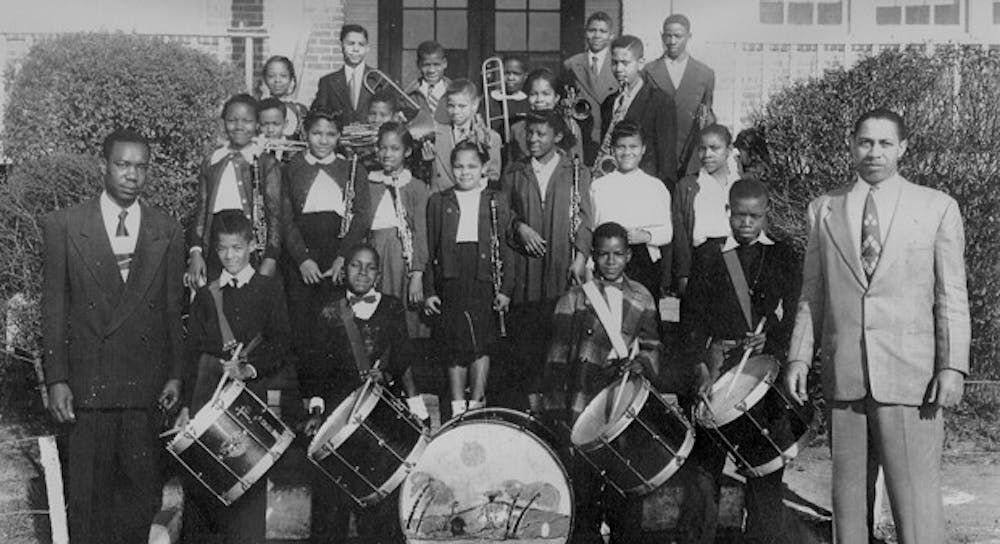Foster attended the school from 1945 to 1951 for grades one through six. Now 73 and still a Chapel Hill resident, Foster said she remembers her years at Northside as happy ones.
“I didn’t have anything to compare it with, so I only have fond memories of it,” she said. “I have many memories of safety and a close-knit community.”
Foster said the school was the heart of the neighborhood, often serving as a place for community events.
One of Foster’s schoolmates was David Mason, who now serves as president of the OCTS-Lincoln High-Northside Alumni Association. He attended the school starting in 1949, by which time overcrowding had forced administrators to split the school day into two shifts — younger students in the morning and upperclassmen in the afternoon.
Mason said students at Northside worked and learned with secondhand materials and desks sent over when the white Chapel Hill schools were done with them.
“I don’t ever recall getting a new book,” he said.
But he said what Northside lacked in resources, it made up for in high-quality teachers.
“The employment opportunities for African-Americans at that time were limited — you could be a teacher or you could be a preacher,” he said.
“So as a result, we had some of the best educators. Our teachers felt like every child could learn.”
In seventh grade, Mason’s teacher used a student’s interest in baseball to improve his math grades.
“She got the paper and started talking with him about the players and the batting averages,” he said. “And she asked him, ‘Well how do you think they come up with these averages?’ That boy went on to be one of the best statisticians at Lincoln High.”
The path to integration
To get the day's news and headlines in your inbox each morning, sign up for our email newsletters.
Kathy Atwater’s first time riding the bus to school came in 1967, when she was redistricted to Glenwood Elementary School. Because Glenwood was previously an all-white school, Atwater knew only one person in her new class.
“Voluntary integration happened when I was in the third grade, but my parents wanted me to stay at Northside. Then, mandatory integration started,” Atwater said. “I wasn’t fearful for the integration part, I was just fearful because I didn’t know people.”
Atwater gradually adjusted to the new school and made friends.
“I think that after everybody got used to this was how it was going to be, they were OK with it,” she said. “I’ve learned this as I got older: Kids don’t have any problem with change.”
But she said older students moving to Chapel Hill High School did not have as easy a time.
Mason’s younger brother was among the first group of black students to attend the integrated high school.
“When he was at Chapel Hill High with other people, he looked around and saw that many experiences that I had were missing,” he said.
Mason and Foster both said extracurricular opportunities for black students were severely limited in activities like cheerleading, band, choir and sports, even though such programs at Lincoln High were award-winning and popular.
After Lincoln and Northside were closed, many of the awards students at those schools won were put in storage, lost or even discarded.
While they said physical altercations were rare, black students dealt with more subtle put-downs, like being ignored by teachers in class.
“We didn’t realize how cheated they felt,” Foster said. “The children that went to the white school sacrificed a lot.”
Returning to Northside
Since the school’s closure, alumni, activists, historians and artists in Chapel Hill have worked to preserve the history of Northside Elementary. At the Marian Cheek Jackson Center, volunteers have been recording the stories of alumni for years.
“We’ve conducted over 200 oral histories of residents and neighbors primarily on the incredible African-American history of Chapel Hill,” said Hudson Vaughan, the center’s associate director, in an email.
Kathy Williams, a lecturer in UNC’s department of dramatic art, worked with N.C. activist group Hidden Voices to produce a theatrical piece on the Northside neighborhood in 2008. Research for the play included interviews with dozens of residents, including Northside Elementary alumni.
“Folks who grew up in Northside and grew up going to that school … were very connected and felt a great deal of pride and love,” Williams said.
“I’ve never had a theatrical experience quite like that.”
Williams said a new school will bring with it a stronger sense of community.
“I think whenever you have a neighborhood school and that brings in families and parents and their events, that does foster that feeling of community,” she said.
Michelle Brownstein, chairwoman of the CHCCS Board of Education, said preserving the character of the neighborhood was a priority for school officials. She noted that the opening of the new school marked the first time children in the neighborhood would be able to walk to school since the closing of the old Northside Elementary.
She said the historical displays in the new school, including the cornerstone as well as memorabilia, photographs and a timeline that will accompany it, were an important part of the school’s design.
When Northside opens next month, nearly 500 children will be in attendance.
And Foster said while she’s just happy to see children back in the neighborhood, she thinks remembering the history of segregation should be a critical part of their education.
“There’s only one race, and that’s the human race, and all that other stuff about ethnicity you just build up in your mind,” she said. “God believes in diversity. That’s why he made us the way he did.”
Contact the desk editor at city@dailytarheel.com.




